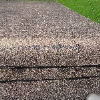


Hurricane Wind Damage to Composition Roofs
 |
 |
 |
 |
 |
 |
 |
|||
Figure 15 |
Figure 16 |
Figure 17 |
Figure 18 |
Figure 19 |
Figure 20 |
Figure 21 |
|||
Click on Photo above to enlarge
Wind damage can come in many forms. Some is evident from the ground and some only while actually upon the roof.
In Figure 15, the shingles have experienced what is know as "Lift". While no shingles have been completely displaced, the tar seal tabs located at the bottom of each shingle have given way to the wind. On newer roofs shingles may easily reseal, however, as a roof ages the tar becomes brittle and the ability to reseal can be lost. In addition, dirt and debris can become lodged under a shingle on the seal tab (See figure 16). This dirt acts much like it would if you placed it upon a piece of masking tape. The tape would immediately lose its adhesive properties.
In Figure 17, wind has also lifted up as shingle. The shingle has layed back down to reseal, however, the shingle was damage by "Creasing".
In figure 18, a piece of airborne debris has struck the ridge of the roof, a very precarious place for damage. Unattended damage to a ridge shingle can allow water to run down rafters in both directions damaging ceiling in a large area. This damage was not visible from the ground.
In Figure 19, wind driven debris has also damaged this shingle. This damage was very hard to find even while on the roof. Wind driven debris damage is very commonly found all over roofs after a bad storm if someone is willing to spend the time to look.
In Figure 20 and 21, tabs to the laminated shingles have been blown off by wind. As the damaged areas still largely blend into the roof, this damage is extremely hard to spot from the ground, especially if the roof is 2 story or not very steep.